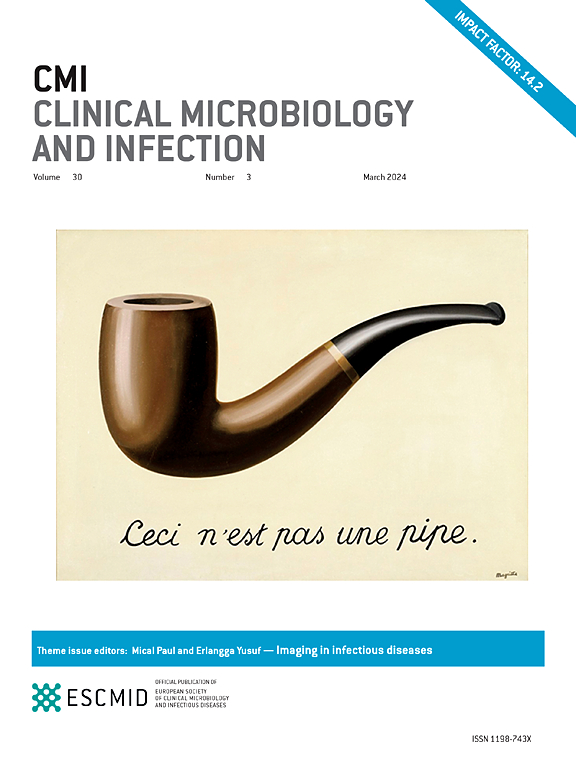孟加拉国肺结核患者的异烟肼耐药性模式:一项探索性研究。
IF 10.9
1区 医学
Q1 INFECTIOUS DISEASES
引用次数: 0
摘要
目标:在孟加拉国等结核病负担较重的国家,研究和政策往往侧重于对利福平(RIF)耐药的结核病患者,而对 RIF 敏感但对异烟肼(INH)耐药(Hr-TB)的患者却得不到诊断。我们的研究旨在确定孟加拉国部分医疗机构中肺结核(PTB)患者对 INH 耐药的流行情况:这项研究在孟加拉国的九个结核病筛查和治疗中心进行。在 2021 年 4 月至 2022 年 12 月期间收集了 1084 名 Xpert 阳性 PTB 患者的痰液样本,并进行了药敏试验(DST)培养。比较了肺结核患者和药敏型肺结核患者的人口统计学和临床特征:998例培养阳性分离株的DST结果显示,无论对RIF是否敏感,对任何INH的耐药率均为6.4%(64/998,95% CI,4.9-8.2)。与新诊断的肺结核患者(5.2%,48/922,95% CI,3.8-6.9)相比,既往接受过治疗的患者的耐药率明显更高(21.1%,16/76,95% CI,12.0-34.2)(p 结论:该研究揭示了结核杆菌的高流行率:这项研究表明,孟加拉国的 Hr-TB 患病率很高,甚至超过了 MDR-TB 的患病率。这突出表明,迫切需要在全国范围内采用世界卫生组织推荐的分子工具来快速检测 INH 耐药性,从而使患者得到及时和适当的治疗。本文章由计算机程序翻译,如有差异,请以英文原文为准。
Isoniazid resistance pattern among pulmonary tuberculosis patients in Bangladesh: An exploratory study
Objectives
In high tuberculosis (TB) burden countries such as Bangladesh, research and policy tend to focus on rifampicin (RIF)-resistant TB patients, leaving RIF-sensitive but isoniazid (INH)-resistant (Hr-TB) patients undiagnosed. Our study aims to determine the prevalence of INH resistance among pulmonary TB patients in selected health care facilities in Bangladesh.
Methods
This study was conducted across nine TB Screening and Treatment Centres situated in Bangladesh. Sputum samples from 1084 Xpert-positive pulmonary TB patients were collected between April 2021 and December 2022 and cultured for drug susceptibility testing. Demographic and clinical characteristics of Hr-TB and drug-susceptible TB patients were compared.
Results
Among available drug susceptibility testing results of 998 culture-positive isolates, the resistance rate of any INH regardless of RIF susceptibility was 6.4% (64/998, 95% CI: 4.9–8.2). The rate was significantly higher in previously treated (21.1%, 16/76, 95% CI: 12.0–34.2) compared with newly diagnosed TB patients (5.2%, 48/922, 95% CI: 3.8–6.9) (p < 0.001). The rate of Hr-TB was 4.5% (45/998, 95% CI: 3.3–6.0), which was also higher among previously treated patients (6.6%, 5/76, 95% CI: 1.4–13.5) compared with newly diagnosed TB patients (4.3%; 40/922, 95% CI: 3.1–5.9) (p 0.350). Most importantly, the rate of Hr-TB was more than double compared with MDR-TB (4.5%, 45/998, vs. 1.9%, 19/998) found in the current study.
Discussion
This study reveals a high prevalence of Hr-TB, surpassing even that of the multi-drug-resistant TB in Bangladesh. This emphasizes the urgent need to adopt WHO-recommended molecular tools at the national level for rapid detection of INH resistance so that patients receive timely and appropriate treatment.
求助全文
通过发布文献求助,成功后即可免费获取论文全文。
去求助
来源期刊
CiteScore
25.30
自引率
2.10%
发文量
441
审稿时长
2-4 weeks
期刊介绍:
Clinical Microbiology and Infection (CMI) is a monthly journal published by the European Society of Clinical Microbiology and Infectious Diseases. It focuses on peer-reviewed papers covering basic and applied research in microbiology, infectious diseases, virology, parasitology, immunology, and epidemiology as they relate to therapy and diagnostics.

 求助内容:
求助内容: 应助结果提醒方式:
应助结果提醒方式:


